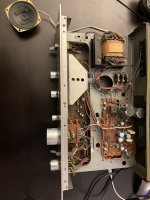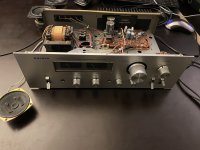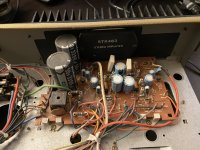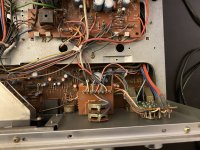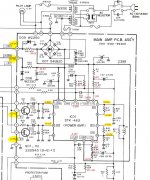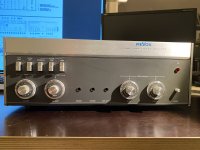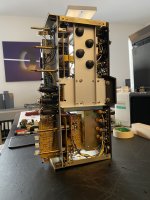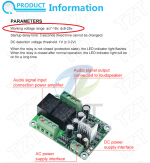Hi there.
So I got that Sanyo DCA-30 which I am intending to hook to my Beovox CX-100 which I am refoaming at the moment.
I am pretty new but got interested in repairing my stuff myself and sinking deeper and deeper...
Anyway I just learned about what biasing is and the difference between Class A / AB in biasing.
My Sanyo DCA-30 works well but I have not used it a year or so and just wanted to check some thing before hoocking it up to my speakers which I put some effort in.
So I measured he DC Voltage on the speaker terminals at zero volume no speakers attached and got following result:
left channel: -240mV
right channel: -277mV
If I understand correctly this amp is working in class A so a higher bias is expected but does this look reasonable to you? and what about that 37mV difference?
I can't find any pots on the boards nor in the circuit to adjust bias.
attached the schematic. I can't find the service manual on the internet.
Any thoughts will be welcome.
So I got that Sanyo DCA-30 which I am intending to hook to my Beovox CX-100 which I am refoaming at the moment.
I am pretty new but got interested in repairing my stuff myself and sinking deeper and deeper...
Anyway I just learned about what biasing is and the difference between Class A / AB in biasing.
My Sanyo DCA-30 works well but I have not used it a year or so and just wanted to check some thing before hoocking it up to my speakers which I put some effort in.
So I measured he DC Voltage on the speaker terminals at zero volume no speakers attached and got following result:
left channel: -240mV
right channel: -277mV
If I understand correctly this amp is working in class A so a higher bias is expected but does this look reasonable to you? and what about that 37mV difference?
I can't find any pots on the boards nor in the circuit to adjust bias.
attached the schematic. I can't find the service manual on the internet.
Any thoughts will be welcome.
Attachments
I finished refoaming the Beovision CX100 drivers.
For testing purposes, I hooked a really cheap speaker (see pictures) to the left channel of the amp and tested at very low volume.
I turned the volume to zero and switched the amp on and off a couple of times. I could observe a big bump of the speakers membrane twice, right after switching on, but not every time. At the end I couldn't reproduce it switching it on and off about 10 times.
But I don't like it and don't want to risk to damage my newly acquired Beovisions.
Is this a sign of capacitor leaking?
Any suggestions would be much appreciated.
Tnx.
coldcat
For testing purposes, I hooked a really cheap speaker (see pictures) to the left channel of the amp and tested at very low volume.
I turned the volume to zero and switched the amp on and off a couple of times. I could observe a big bump of the speakers membrane twice, right after switching on, but not every time. At the end I couldn't reproduce it switching it on and off about 10 times.
But I don't like it and don't want to risk to damage my newly acquired Beovisions.
Is this a sign of capacitor leaking?
Any suggestions would be much appreciated.
Tnx.
coldcat
Attachments
hi
This Sanyo amp is a cheap amp made in Portugal at the time! This is not a class A amplifier, class A is not suitable for this kind of power integrated circuit because in class A the heat release is very important! On these integrated circuits there is no bias adjustment and the voltage difference on the outputs terminals without signal is normal and within the tolerances of 300mV! Finally, there is no time delay for turning on the loudspeakers, so it is completely normal to see the membrane move when the power is turned on (the famous pop at the output when the power is turned on)! You can equip it with a protection circuit found on aliexpress.
https://fr.aliexpress.com/item/1005...o2fra&spm=a2g0o.order_list.0.0.21ef5e5bIvuu4d
This Sanyo amp is a cheap amp made in Portugal at the time! This is not a class A amplifier, class A is not suitable for this kind of power integrated circuit because in class A the heat release is very important! On these integrated circuits there is no bias adjustment and the voltage difference on the outputs terminals without signal is normal and within the tolerances of 300mV! Finally, there is no time delay for turning on the loudspeakers, so it is completely normal to see the membrane move when the power is turned on (the famous pop at the output when the power is turned on)! You can equip it with a protection circuit found on aliexpress.
https://fr.aliexpress.com/item/1005...o2fra&spm=a2g0o.order_list.0.0.21ef5e5bIvuu4d
Last edited:
Thanks a lot Mongis for the clarification.hi
This Sanyo amp is a cheap amp made in Portugal at the time! This is not a class A amplifier, class A is not suitable for this kind of power integrated circuit because in class A the heat release is very important! On these integrated circuits there is no bias adjustment and the voltage difference on the outputs terminals without signal is normal and within the tolerances of 300mV! Finally, there is no time delay for turning on the loudspeakers, so it is completely normal to see the membrane move when the power is turned on (the famous pop at the output when the power is turned on)! You can equip it with a protection circuit found on aliexpress.
https://fr.aliexpress.com/item/1005...o2fra&spm=a2g0o.order_list.0.0.21ef5e5bIvuu4d
I had a feeling this can't the best class of equipment but liked the look of it somehow. Anyway I found a very good deal of a Revox A78 MKII and started to put my time in that one, leaving the Sanyo as it is for the moment. The protection circuit is a good input, I'll probably go with this option another time.
The build quality of my new Revox is astonishing, making it much more fun to work on. There is also much more documentation about it here in Europe.
Have a nice day.
Attachments
hi
Be careful, however, even with this new Revox amplifier because you will have the same disadvantages as with the Sanyo. Because on this device you still don't have the speaker activation delay ! On the other hand, there is protection against short circuits on the speaker output and an offset and bias adjustment so this point is a good one! I therefore advise you to get the small circuit from aliexpress to protect the speakers.

Be careful, however, even with this new Revox amplifier because you will have the same disadvantages as with the Sanyo. Because on this device you still don't have the speaker activation delay ! On the other hand, there is protection against short circuits on the speaker output and an offset and bias adjustment so this point is a good one! I therefore advise you to get the small circuit from aliexpress to protect the speakers.
Hi Mongis
thanks a lot for the suggestions!
I replaced all the trim pots and electrolytic caps as advised by people doing revision work on that particular model because on one channel I couldn't get the bias in the right range. Waiting for the 4 big filter caps also.
This protection circuit, where exactly will it be placed in the original circuit? I'll order 2 or 3 right now.
Tnx again.
EDIT: never mind, I just realized it's well documented on that product page..
thanks a lot for the suggestions!
I replaced all the trim pots and electrolytic caps as advised by people doing revision work on that particular model because on one channel I couldn't get the bias in the right range. Waiting for the 4 big filter caps also.
This protection circuit, where exactly will it be placed in the original circuit? I'll order 2 or 3 right now.
Tnx again.
EDIT: never mind, I just realized it's well documented on that product page..
Hi
Its quit right explain on the website of alli express:
https://fr.aliexpress.com/item/1005...o2fra&spm=a2g0o.order_list.0.0.21ef1802lXFNd3
Its quit right explain on the website of alli express:
https://fr.aliexpress.com/item/1005...o2fra&spm=a2g0o.order_list.0.0.21ef1802lXFNd3
Dear Mongis
are you sure there is an advantage plugging in that protection circuit for the Revox?
Translated from a German forum:
User1: "Not much can happen to the speakers, the A78 "only" has a capacitive mass."
another user's response:
"User1 is right.
The ground consists of only one connection, which is connected to the two operating voltages with 3.3 kOhm // 5 milliFarad each."
are you sure there is an advantage plugging in that protection circuit for the Revox?
Translated from a German forum:
User1: "Not much can happen to the speakers, the A78 "only" has a capacitive mass."
another user's response:
"User1 is right.
The ground consists of only one connection, which is connected to the two operating voltages with 3.3 kOhm // 5 milliFarad each."
hi
In your case, it is to avoid the pop when the amplifier is switched on because there is a time delay for putting the loudspeakers into service on this protection card. The protection in case of destruction of the output transistors is indeed an additional security because this revox amp is equipped with protection against short circuits at the output so 'in principle' the output transistors are protected.
In your case, it is to avoid the pop when the amplifier is switched on because there is a time delay for putting the loudspeakers into service on this protection card. The protection in case of destruction of the output transistors is indeed an additional security because this revox amp is equipped with protection against short circuits at the output so 'in principle' the output transistors are protected.
Ok thanks again. I will include this circuit then.
One last question (hopefully):
There seems to be a turn off protection also on that little board.
I can just get the 24V DC from the power board for the circuit protection. But for the turn-off protection to work it has to be an AC Voltage from a separate transformer, do I understand this correct?
But I don't really need turn off protection because the filter caps slowly bleed out when I turn the amp off?
One last question (hopefully):
There seems to be a turn off protection also on that little board.
I can just get the 24V DC from the power board for the circuit protection. But for the turn-off protection to work it has to be an AC Voltage from a separate transformer, do I understand this correct?
But I don't really need turn off protection because the filter caps slowly bleed out when I turn the amp off?
I probably should start a new topic because we are talking more about the Revox than the Sanyo.
BTW: Even after recapping all electrolytic caps I couldn't get the bias right in one channel. I first suspected Q503 after measuring in circuit, desoldered it, but it was good then. It turned out the collector pins of Q503 and Q504 were shorted together over the shared heatsink! The heat transfer plastic somehow was not in a good shape. Or maybe the mounting screws were touching the heat transfer plate of the transistor from the side. Anyway, I found some new pads from other transistors, adjusted bias and bias offset, hooked up the beovision speakers for the first time and everything is working fine now. The Revox now sounds pretty good in my ears.
BTW: Even after recapping all electrolytic caps I couldn't get the bias right in one channel. I first suspected Q503 after measuring in circuit, desoldered it, but it was good then. It turned out the collector pins of Q503 and Q504 were shorted together over the shared heatsink! The heat transfer plastic somehow was not in a good shape. Or maybe the mounting screws were touching the heat transfer plate of the transistor from the side. Anyway, I found some new pads from other transistors, adjusted bias and bias offset, hooked up the beovision speakers for the first time and everything is working fine now. The Revox now sounds pretty good in my ears.
I know, I just was wondering about the extended function (also on shut off) when using AC power...the protection board works from 8 to 28Vdc!
- Home
- Amplifiers
- Solid State
- Sanyo DCA 30 bias adjust?
